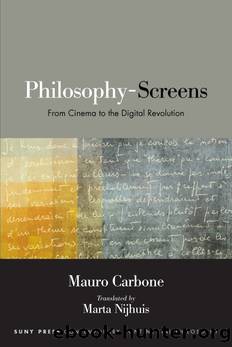Philosophy-Screens by Mauro Carbone;

Author:Mauro Carbone;
Language: eng
Format: epub
Publisher: State University of New York Press
Published: 2019-07-14T16:00:00+00:00
5
Come Live with Me
The Seduction of the Screens Today
The real ones want fictional lives and the fictional ones want real lives.
—Woody Allen, The Purple Rose of Cairo
The Arche-Screen as a “Quasi-Subject”
The screen diverts, the screen captivates. The screen diverts and captivates at once. To say it with a single word, the screen seduces. In short, it takes us with it. Literally. To the point of inviting us to live with it.
This strategy of seduction, which is at once fascinating and troubling, has accompanied the cinema since its very origins. In 1902, Uncle Josh is so affected by it as a spectator that he gets to the point of ripping the screen down and to engage in a fight with the projectionist hidden behind it. Of course, in this way Uncle Josh at the Moving Picture Show—a film produced by the Edison Company and directed by Edwin S. Porter—shows that at the time the seduction of the screen was still connected to the reference to its beyond, which concealed its secret: the machinery. It also has to be remarked that this film echoes the famous anecdote—never historically proven—according to which on the occasion of the first projection of Louis Lumière’s L’arrivée d’un train en gare de La Ciotat (The Arrival of a Train at La Ciotat Station), the spectators escaped from the movie hall, fearing that the wagon would run over them by exiting the screen. However, what is all the more important to highlight here is that the film produced by the Edison Company already shows a movie spectator who is so much captivated by the screen, he tries to enter it. This attempt and this temptation were destined to produce a most fundamental topos in the history of cinema and beyond. Actually, it seems to me that the cinematic experience of the screen finds a special expression in such a topos. Or, more subtly, what finds a special expression in such a topos is the experience of the screen that the cinema at once promises and threatens its spectators to live.1 To linger over it for a little while would thus allow us not only to better understand such an experience of the screen; it would also allow us to estimate how this experience changes in electronic and digital media by observing the changes that these very media introduce in that topos.2 In this way, we could specify both expectations and worries aroused by the peculiar immersivity of those media with respect to the kind of immersivity offered by the cinema.
Uncle Josh’s temptation of entering the screen in the Edison movie will significantly become the little projectionist’s dream in Buster Keaton’s 1924 film Sherlock Jr.: a dream soon troubled by the continuous time-gap between the whirligig of situations on the screen and the actions by which the projectionist faces them.
Download
This site does not store any files on its server. We only index and link to content provided by other sites. Please contact the content providers to delete copyright contents if any and email us, we'll remove relevant links or contents immediately.
The remains of the day by Kazuo Ishiguro(7540)
Tools of Titans by Timothy Ferriss(6934)
The Black Swan by Nassim Nicholas Taleb(6182)
Inner Engineering: A Yogi's Guide to Joy by Sadhguru(5886)
Giovanni's Room by James Baldwin(5870)
The Way of Zen by Alan W. Watts(5787)
The Six Wives Of Henry VIII (WOMEN IN HISTORY) by Fraser Antonia(4784)
The Power of Now: A Guide to Spiritual Enlightenment by Eckhart Tolle(4747)
Astrophysics for People in a Hurry by Neil DeGrasse Tyson(4613)
Asking the Right Questions: A Guide to Critical Thinking by M. Neil Browne & Stuart M. Keeley(4564)
12 Rules for Life by Jordan B. Peterson(3722)
The Ethical Slut by Janet W. Hardy(3494)
Skin in the Game by Nassim Nicholas Taleb(3455)
Housekeeping by Marilynne Robinson(3395)
The Art of Happiness by The Dalai Lama(3376)
Double Down (Diary of a Wimpy Kid Book 11) by Jeff Kinney(3267)
Skin in the Game: Hidden Asymmetries in Daily Life by Nassim Nicholas Taleb(3259)
Walking by Henry David Thoreau(3227)
12 Rules for Life: An Antidote to Chaos by Jordan B. Peterson(3195)
